Prepositions and Case Theory
- 1. Diego Gabriel Krivochen (UNLP, Universit├żt Potsdam)
- 2. Previous approaches Pesetsky & Torrego (2001, 2004, 2007) ’éŚ Vehicle Requirement on Merge (2007: 1): If ╬▒ and ╬▓ merge, some feature F of ╬▒ must probe F on ╬▓. ’éŚ Conditions for Probing: C-command Feature identity
- 3. A model of Agree ’éŚ Agree (Feature sharing version) i) An unvalued feature F (a probe) on a head H at syntactic location ╬▒ (F╬▒) scans its c-command domain for another instance of F (a goal) at location ╬▓ (F╬▓) with which to agree. ii) Replace F╬▒ with F╬▓, so that the same feature is present in both locations.
- 4. Problems ’éŚ C-command is stipulatively defined upon 2-D tree-like representations. ’éŚ Restrictions on Merge: the operation does not follow from conceptual necessity but from intra-theoretical needs. ’éŚ Substantive complications: features, values, operations (Agree = Search + Copy Value)
- 5. Case in P&TŌĆÖs model ’éŚ Relation between Case in NPs and T finiteness (P&T, 2000: 5): ŌĆ£The nature of nominative case Nominative case is uT on D.ŌĆØ uT on D is valued by non-defective T The concept is extended to ACC case, depending on the T node that values the uninterpretable feature on D.
- 6. Case as a subtype of Agree ’éŚ NOM = [TS [u-Žå]ŌĆ”DP[u-T]] ’éŚ ACC = [TO [u-Žå] ŌĆ”DP [u-T]]
- 7. Case in Radical Minimalism ’éŚ Case is a configurational relation, not a substantive element (Cf. P&T, Chomsky) ’éŚ Relation between Theta-Theory and Case Theory: ’éŚ The optimal scenario would be that in which there is a univoque relation between theta positions and theta roles, and a Case interpretation for each theta-position.
- 8. DeLancey (2001) ’éŚ ŌĆ£(ŌĆ”) suppose we could demonstrate that there are, say, exactly x universal semantic roles which can occur as core arguments in a clause in human language. The most obvious language design would have x case markers, one for each underlying role; every argument would simply be marked for its semantic role, which could then be read directly off the surface morphosyntax (ŌĆ”)ŌĆØ (our highlighting)
- 9. vP ╬Ė1 v [CAUSE] VP [GO/BE] PP ╬Ė2 P [WITH] / [TO] ╬Ė3
- 10. ’éŚ Initiator will be assigned to the position ╬Ė1, Theme (for Figure) and Location (for Ground) vary between ╬Ė2 and ╬Ė3 depending on the nature of the P head, central or terminal coincidence. If P is central, then the Ground will ╬Ė2 and ╬Ė3, Figure, while if P is terminal, it will be the other way around. ’éŚ Force is within the ŌĆŗInitiator sphere Percept ("perceived entity") in the area of ŌĆŗTheme Source, Path, Goal, Experiencer (see De Lancey, 2001), are interpreted within the Location sphere.
- 11. ’éŚ Case is the result of the local relationship between an argument and a functional-procedural node. ’éŚ We will work with a system of three cases, also structured as "spheres", in close relation to thematic roles. These underlying and universal cases would be Nominative, Accusative and Dative, names that we maintain as a matter of convenience and expository purposes, but we really should talk about an Initiator Case (Agent / Force), a Theme Case and a Location Case (comprising variants of terminal / central coincidence), regardless possibilities of morphological realization in different languages. ’éŚ ŌĆó Nominative - Initiator ŌĆó Accusative - Theme ŌĆó Dative - Location
- 12. ’éŚ Nominative: read off from a {Time, {D}} local relation, and interpreted thematically (in the explicature building process, see Sperber & Wilson, 2003) as Agent / Force ’éŚ Accusative: read off from a {Cause, {D}} local relation, and interpreted thematically as Theme, the object (Figure) located in / moving towards, etc. a Ground ’éŚ Dative: read off from a {P, {D}} local relation, and interpreted thematically as Location, the Ground in TalmyŌĆÖs terms.
- 13. An essential claim is that the spheres are not «far apart», but in interaction, and there are points of contact. There are elements, uses of the VI corresponding canonically to one «Case» that appear in unusual configurations: of these, we will say they are «intersective uses» of the Cases (blue circles): NOM ACC DAT
- 14. Examples: Accusative > Dative: ACC expresses location in space, time or property (i, ii and iii), or goal in movement (iv). ’éŚ Direction Accusative: Latin: Eo RomamACC (Lit. Go Rome ŌĆ£I go towards/to RomeŌĆØ) Sanskrit: gr─ümamACC gacchami (Lit. Town go ŌĆ£I go to the townŌĆØ) Polish: id─Ö na poczt─ÖACC ŌĆśI am going to the post officeŌĆÖ, id┼║ po niegoACC ŌĆśgo for him (go to pick him up)ŌĆÖ ’éŚ Temporal Accusative: Latin: quamdiu, quamdudum, quanto tempore complements.
- 15. ŌĆóŌĆ£Double accusativeŌĆØ in ditransitive constructions: traditionally referred to as ŌĆ£thing ACCŌĆØ and ŌĆ£person ACCŌĆØ, they are within the P domain, as Theme and Goal. Latin: Verres MilesiosACC navemACC poposcit. (Lit. Verres the milesians ship asked ŌĆ£Verres asked a ship to the milesiansŌĆØ), Quid meACC istudACC rogas? (Lit. Why to-me this ask? ŌĆ£Why do you ask me this?ŌĆØ) Greek: ╬┤╬╣╬┤╬¼Žé╬║Žē Žä╬┐ŽŹŽā ŽĆ╬▒├«╬┤╬▒Žā Žä╬«╬Į ╬│Žü╬▒╬╝╬╝╬▒Žä╬╣╬║╬«╬Į [did├Īsk┼Ź to├║s pa├«dasACC tßĖŚn grammatikßĖŚnACC] (Lit. I teach to-the children grammar ŌĆ£I teach grammar to the childrenŌĆØ) Sanskrit: r─üj─ünamACC vacanamACC abrav─½t (Lit. King some words said ŌĆ£(He/She) said some words to the kingŌĆØ)
- 16. Accusative > Nominative: ACC is the overt subject in non-finite clauses. ŌĆóECM (Exceptional Case Marking): Ingl├®s: I want [themACC to come] Lat├Łn: Video [teACC venire] (Lit. See you to-come, ŌĆ£I see you comingŌĆØ) Griego: ╬╗╬Ł╬│╬Ą╬╣ Žé╬Ą ß╝É╬╗╬Ė╬Ą├«╬Į [l├®gei [seACC elthe├«nINF]] (Lit. dice te haber venido ŌĆōactive aorist infinitive- ŌĆ£(He/She) says you have comeŌĆØ) Polish: Widz─Ö ci─ÖACC spi─ģcego. (ŌĆśI see you sleeping.ŌĆÖ) Dative > Nominative: Dative appears in subject position in the Spelled-Out form. ŌĆóQuirky case: Icelandic: HenniDAT leiddust ŽĖ NOM (Lit. Her bored they ŌĆ£They bored herŌĆØ) eir MerDAT ŽĖ [MariaNOM vera garfu─æ] (Lit. To me seems Mary be intelligent ├│tti ŌĆ£Mary seems to me to be intelligentŌĆØ) Polish: MariiNOM znudzi┼éa si─Ö pracaNOM. (ŌĆśMary got bored with workŌĆÖ) JanowiDAT podoba si─Ö we W┼éoszech. (ŌĆśJohn likes it in Italy.ŌĆÖ) Spanish: A JuanDAT leDAT basta con eso. (cf. Fernandez Soriano, 1999) A Mar├ŁaDAT leDAT gusta el jazz
- 17. Values of the Genitive (DAT Sphere) ’éŚ Posession (material or metaphorical): Sanskrit: Damayanty─üs svayaß╣ābaras (Lit. DamayantiŌĆÖs choice) Latin: id est domusNOM regisGEN (Lit. This is house of the king ŌĆ£This is the house of the kingŌĆØ) Greek: ß╝Ī ╬┐ß╝░╬║╬»╬▒ Žä╬┐├╗ ŽĆ╬▒ŽäŽüŽīŽā [h─ō oik├Ła to├╗ patr├│sGEN] (Lit. The house of the father) Polish: sprawaNOM MariiGEN (ŌĆśMaryŌĆÖs business/matterŌĆÖ) ’éŚ Origin: Latin: AlteriusGEN partisGEN periculum (Lit. Somewhere else danger ŌĆ£The danger [coming] from somewhere elseŌĆØ) Greek (either concrete ŌĆōcities- or abstract locations ŌĆōfamilies-): ╬ŻŽē╬║Žü╬¼Žä╬ĘŽā ßĮü ŽéŽēŽåŽü╬┐╬Į╬»Žé╬║╬┐Žģ [S┼Źkr├Īt─ōs ho s┼Źfron├Łskou] (Lit. Socrates SofroniscoGEN ŌĆ£Socrates, son of SofroniscoŌĆØ), ß╝ł╬Ė╬Ą╬Į╬▒╬»Žē╬Į [Athen├Īi┼Źn] (ŌĆ£Socrates from AthensŌĆØ). Polish: ha┼éasNOM ulicyGEN ŌĆśnoise of the streetŌĆÖ ’éŚ Quality (Only for individual level predicates, for stage level predicates ablative case is used): Latin: Vir magnaeGEN auctoritatisGEN (Lit. Man of great authority) Polish: cz┼éowiekNOM honoruGEN (a person/man of honour)
- 18. ’éŚ Location ŌĆ£throughŌĆØ: Greek: ╬Ė╬Ł╬┐ŽģŽé╬▒╬╣ ŽĆ╬Ą╬┤╬»╬┐╬╣╬┐ [th├®ousai ped├ŁoioGEN] (Lit. Running meadowGEN ŌĆ£Running through the meadowŌĆØ) ’éŚ Goal: Sanskrit: Pr─üjapaterGEN ─ütm─ünam paridad─ümi (Lit. Prajapati myself give ŌĆ£I give myself to PrajapatiŌĆØ) ’éŚ Source: Greek: ╬« ŽĆ╬┐╬╗ŽŹŽā oßĮÉ ŽĆ╬┐╬╗ŽŹ ╬▒ŽĆ╬ŁŽć╬Ą╬╣ Žä╬«Žā ß╝źŽĆ╬Ą╬╣ŽüŽģ [hßĖŚ pol├Įs ├║ pol├Į ap├®khei tßĖŚs hßĖŚpeiru] (Lit. The city not far away from the coast ŌĆ£The city is not far away from the coast / departing from the coastŌĆØ) Polish: mlekoNOM od krowyGEN (Lit. milk from the cow, ŌĆścow milkŌĆÖ) ’éŚ Part-whole: ŌĆ£partitive GenitiveŌĆØ Latin: Magna pars ItaliaeGEN (ŌĆ£A big part of ItalyŌĆØ) Greek: ŽĆŽīŽä╬ĄŽü╬┐Žā ŽäßĮĮ╬Į ╬▒╬┤╬Ą╬╗ŽåßĮĮ╬Į [p├│teros tß╣ōn adelfß╣ōnGEN] (ŌĆ£Which of the brothers?ŌĆØ) Polish: butelkaNOM wodyGEN (ŌĆśa bottle of waterŌĆÖ)
- 19. ’éŚ However, all uses locative establish a locative relation between nominals, either concrete or abstract: a nominal "belongs" to another in a concrete or abstract, metaphorical way. Belonging is a type of location (either central or terminal coincidence). Therefore, we propose to subsume all of these uses the "sphere of Dative". ’éŚ E.g.: JohnŌĆÖs bag [V BE [P John [[WITH CENTRAL] bag]]
- 20. ’éŚ Is English [ŌĆśs] a CL (Radeva-Bork, 2012) or a case mark? Abney (1987) supports the idea it is a CL in D0 raising to Spec-DP, but: ’éŚ It is not an argument, rather, a locative predicate ’éŚ It only appears within full DP nominals, not with pronouns, which inflect for Case: i) A friend of [DP JohnŌĆÖs] ii) A friend of mine iii) *A friend of [DP [[D mineŌĆÖs] ŌłÜ├ś]] (see Panagiotidis, 2002 for an analysis of pronouns as D with empty root complements)
- 21. ’éŚ There is, however, another type of "genitiveŌĆØ: the "Subjective" and ŌĆ£Objective", which appear in nominalizations as a light PP. These kinds of genitive also establish a locative relation between nominals: a conceptual event, syntactically categorized as a nominal, and a participant, either agent / initiator or theme. This conceptual relation must be syntactically realized without losing information (CP). This does not imply that there is a transformational relation between the nominalization and the tensed sentence form, but the explicature building process is analogous. These ŌĆ£genitivesŌĆØ are common features of Romance and Germanic languages, so they can not be considered an isolated anomaly.
- 22. Relational Semantic Structure (Mateu, 2000; Jackendoff, 1987) T [event] r Figure r P Ground E.g.: [T arrive [r Mary [r AT] the house]]
- 23. Possible Syntactic Realizations: non-transparent interface {time} {D} [time] {event} [D] {event} [event] {P} [event] {P} {D} {P} {D} {P} P {D} P {D} Mary arrived (at the house) Mary┬┤s arrival (at the house)
- 24. Causative constructions R Italia R [cause] T [GO] r Albania r [WITH] invasi├│n
- 25. Syntactic instantiations {D} {time} La {cause} [time] {cause} {P} {cause} {D} {cause} P ŌłÜItalia D ŌłÜItalia [cause] {event} [cause] {event} ├ś ├ś {P} {event} {event} {D} de {D} [event] ŌłÜinvasi├│n D ŌłÜAlbania [event] ŌłÜinvasi├│n D ŌłÜAlbania

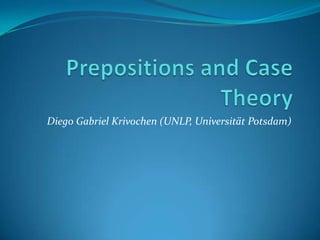



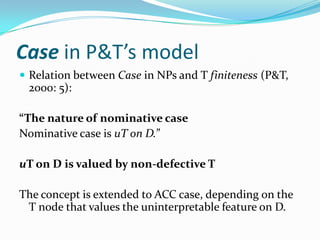
![Case as a subtype of Agree
’éŚ NOM = [TS [u-Žå]ŌĆ”DP[u-T]]
’éŚ ACC = [TO [u-Žå] ŌĆ”DP [u-T]]](https://image.slidesharecdn.com/prepositionsandcaseseminarpotsdam2012-120803163807-phpapp02/85/Prepositions-and-Case-Theory-6-320.jpg)
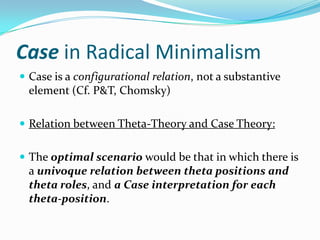
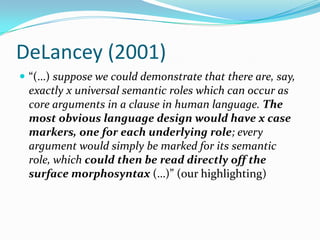
![vP
╬Ė1 v
[CAUSE] VP
[GO/BE] PP
╬Ė2 P
[WITH] / [TO] ╬Ė3](https://image.slidesharecdn.com/prepositionsandcaseseminarpotsdam2012-120803163807-phpapp02/85/Prepositions-and-Case-Theory-9-320.jpg)

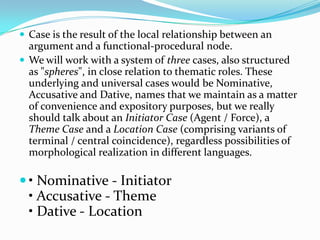

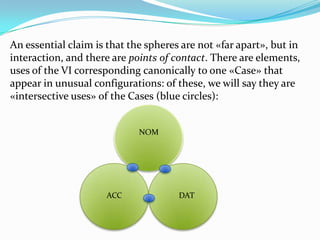
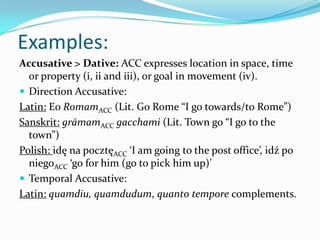
![ŌĆóŌĆ£Double accusativeŌĆØ in ditransitive constructions: traditionally
referred to as ŌĆ£thing ACCŌĆØ and ŌĆ£person ACCŌĆØ, they are within the
P domain, as Theme and Goal.
Latin: Verres MilesiosACC navemACC poposcit. (Lit. Verres the
milesians ship asked ŌĆ£Verres asked a ship to the milesiansŌĆØ),
Quid meACC istudACC rogas? (Lit. Why to-me this ask? ŌĆ£Why do
you ask me this?ŌĆØ)
Greek: ╬┤╬╣╬┤╬¼Žé╬║Žē Žä╬┐ŽŹŽā ŽĆ╬▒├«╬┤╬▒Žā Žä╬«╬Į ╬│Žü╬▒╬╝╬╝╬▒Žä╬╣╬║╬«╬Į [did├Īsk┼Ź to├║s
pa├«dasACC tßĖŚn grammatikßĖŚnACC] (Lit. I teach to-the children
grammar ŌĆ£I teach grammar to the childrenŌĆØ)
Sanskrit: r─üj─ünamACC vacanamACC abrav─½t (Lit. King some words
said ŌĆ£(He/She) said some words to the kingŌĆØ)](https://image.slidesharecdn.com/prepositionsandcaseseminarpotsdam2012-120803163807-phpapp02/85/Prepositions-and-Case-Theory-15-320.jpg)
![Accusative > Nominative: ACC is the overt subject in non-finite clauses.
ŌĆóECM (Exceptional Case Marking):
Ingl├®s: I want [themACC to come]
Lat├Łn: Video [teACC venire] (Lit. See you to-come, ŌĆ£I see you comingŌĆØ)
Griego: ╬╗╬Ł╬│╬Ą╬╣ Žé╬Ą ß╝É╬╗╬Ė╬Ą├«╬Į [l├®gei [seACC elthe├«nINF]] (Lit. dice te haber venido ŌĆōactive
aorist infinitive- ŌĆ£(He/She) says you have comeŌĆØ)
Polish: Widz─Ö ci─ÖACC spi─ģcego. (ŌĆśI see you sleeping.ŌĆÖ)
Dative > Nominative: Dative appears in subject position in the Spelled-Out
form.
ŌĆóQuirky case:
Icelandic: HenniDAT leiddust ŽĖ NOM (Lit. Her bored they ŌĆ£They bored herŌĆØ)
eir
MerDAT ŽĖ [MariaNOM vera garfu─æ] (Lit. To me seems Mary be intelligent
├│tti
ŌĆ£Mary seems to me to be intelligentŌĆØ)
Polish: MariiNOM znudzi┼éa si─Ö pracaNOM. (ŌĆśMary got bored with workŌĆÖ)
JanowiDAT podoba si─Ö we W┼éoszech. (ŌĆśJohn likes it in Italy.ŌĆÖ)
Spanish: A JuanDAT leDAT basta con eso. (cf. Fernandez Soriano, 1999)
A Mar├ŁaDAT leDAT gusta el jazz](https://image.slidesharecdn.com/prepositionsandcaseseminarpotsdam2012-120803163807-phpapp02/85/Prepositions-and-Case-Theory-16-320.jpg)
![Values of the Genitive (DAT Sphere)
’éŚ Posession (material or metaphorical):
Sanskrit: Damayanty─üs svayaß╣ābaras (Lit. DamayantiŌĆÖs choice)
Latin: id est domusNOM regisGEN (Lit. This is house of the king ŌĆ£This is the house
of the kingŌĆØ)
Greek: ß╝Ī ╬┐ß╝░╬║╬»╬▒ Žä╬┐├╗ ŽĆ╬▒ŽäŽüŽīŽā [h─ō oik├Ła to├╗ patr├│sGEN] (Lit. The house of the father)
Polish: sprawaNOM MariiGEN (ŌĆśMaryŌĆÖs business/matterŌĆÖ)
’éŚ Origin:
Latin: AlteriusGEN partisGEN periculum (Lit. Somewhere else danger ŌĆ£The danger
[coming] from somewhere elseŌĆØ)
Greek (either concrete ŌĆōcities- or abstract locations ŌĆōfamilies-): ╬ŻŽē╬║Žü╬¼Žä╬ĘŽā ßĮü
ŽéŽēŽåŽü╬┐╬Į╬»Žé╬║╬┐Žģ [S┼Źkr├Īt─ōs ho s┼Źfron├Łskou] (Lit. Socrates SofroniscoGEN
ŌĆ£Socrates, son of SofroniscoŌĆØ), ß╝ł╬Ė╬Ą╬Į╬▒╬»Žē╬Į [Athen├Īi┼Źn] (ŌĆ£Socrates from
AthensŌĆØ).
Polish: ha┼éasNOM ulicyGEN ŌĆśnoise of the streetŌĆÖ
’éŚ Quality (Only for individual level predicates, for stage level predicates ablative
case is used):
Latin: Vir magnaeGEN auctoritatisGEN (Lit. Man of great authority)
Polish: człowiekNOM honoruGEN (a person/man of honour)](https://image.slidesharecdn.com/prepositionsandcaseseminarpotsdam2012-120803163807-phpapp02/85/Prepositions-and-Case-Theory-17-320.jpg)
![’éŚ Location ŌĆ£throughŌĆØ:
Greek: ╬Ė╬Ł╬┐ŽģŽé╬▒╬╣ ŽĆ╬Ą╬┤╬»╬┐╬╣╬┐ [th├®ousai ped├ŁoioGEN] (Lit. Running
meadowGEN ŌĆ£Running through the meadowŌĆØ)
’éŚ Goal:
Sanskrit: Pr─üjapaterGEN ─ütm─ünam paridad─ümi (Lit. Prajapati myself
give ŌĆ£I give myself to PrajapatiŌĆØ)
’éŚ Source:
Greek: ╬« ŽĆ╬┐╬╗ŽŹŽā oßĮÉ ŽĆ╬┐╬╗ŽŹ ╬▒ŽĆ╬ŁŽć╬Ą╬╣ Žä╬«Žā ß╝źŽĆ╬Ą╬╣ŽüŽģ [hßĖŚ pol├Įs ├║ pol├Į ap├®khei
tßĖŚs hßĖŚpeiru] (Lit. The city not far away from the coast ŌĆ£The city is
not far away from the coast / departing from the coastŌĆØ)
Polish: mlekoNOM od krowyGEN (Lit. milk from the cow, ŌĆścow milkŌĆÖ)
’éŚ Part-whole: ŌĆ£partitive GenitiveŌĆØ
Latin: Magna pars ItaliaeGEN (ŌĆ£A big part of ItalyŌĆØ)
Greek: ŽĆŽīŽä╬ĄŽü╬┐Žā ŽäßĮĮ╬Į ╬▒╬┤╬Ą╬╗ŽåßĮĮ╬Į [p├│teros tß╣ōn adelfß╣ōnGEN] (ŌĆ£Which of
the brothers?ŌĆØ)
Polish: butelkaNOM wodyGEN (ŌĆśa bottle of waterŌĆÖ)](https://image.slidesharecdn.com/prepositionsandcaseseminarpotsdam2012-120803163807-phpapp02/85/Prepositions-and-Case-Theory-18-320.jpg)
![’éŚ However, all uses locative establish a locative relation
between nominals, either concrete or abstract: a
nominal "belongs" to another in a concrete or abstract,
metaphorical way. Belonging is a type of location
(either central or terminal coincidence). Therefore, we
propose to subsume all of these uses the "sphere of
Dative".
’éŚ E.g.: JohnŌĆÖs bag
[V BE [P John [[WITH CENTRAL] bag]]](https://image.slidesharecdn.com/prepositionsandcaseseminarpotsdam2012-120803163807-phpapp02/85/Prepositions-and-Case-Theory-19-320.jpg)
![’éŚ Is English [ŌĆśs] a CL (Radeva-Bork, 2012) or a case mark?
Abney (1987) supports the idea it is a CL in D0 raising to
Spec-DP, but:
’éŚ It is not an argument, rather, a locative predicate
’éŚ It only appears within full DP nominals, not with
pronouns, which inflect for Case:
i) A friend of [DP JohnŌĆÖs]
ii) A friend of mine
iii) *A friend of [DP [[D mineŌĆÖs] ŌłÜ├ś]] (see Panagiotidis,
2002 for an analysis of pronouns as D with empty root
complements)](https://image.slidesharecdn.com/prepositionsandcaseseminarpotsdam2012-120803163807-phpapp02/85/Prepositions-and-Case-Theory-20-320.jpg)

![Relational Semantic Structure
(Mateu, 2000; Jackendoff, 1987)
T
[event] r
Figure r
P Ground
E.g.: [T arrive [r Mary [r AT] the house]]](https://image.slidesharecdn.com/prepositionsandcaseseminarpotsdam2012-120803163807-phpapp02/85/Prepositions-and-Case-Theory-22-320.jpg)
![Possible Syntactic Realizations:
non-transparent interface
{time} {D}
[time] {event} [D] {event}
[event] {P} [event] {P}
{D} {P} {D} {P}
P {D} P {D}
Mary arrived (at the house) Mary┬┤s arrival (at the house)](https://image.slidesharecdn.com/prepositionsandcaseseminarpotsdam2012-120803163807-phpapp02/85/Prepositions-and-Case-Theory-23-320.jpg)
![Causative constructions
R
Italia R
[cause] T
[GO] r
Albania r
[WITH] invasi├│n](https://image.slidesharecdn.com/prepositionsandcaseseminarpotsdam2012-120803163807-phpapp02/85/Prepositions-and-Case-Theory-24-320.jpg)
![Syntactic instantiations
{D} {time}
La {cause} [time] {cause}
{P} {cause} {D} {cause}
P ŌłÜItalia D ŌłÜItalia
[cause] {event} [cause] {event}
├ś ├ś
{P} {event} {event}
{D}
de {D} [event] ŌłÜinvasi├│n D ŌłÜAlbania [event] ŌłÜinvasi├│n
D ŌłÜAlbania](https://image.slidesharecdn.com/prepositionsandcaseseminarpotsdam2012-120803163807-phpapp02/85/Prepositions-and-Case-Theory-25-320.jpg)